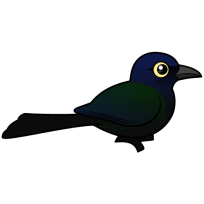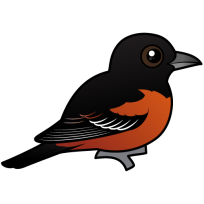Also known as: Maybird, Butterbird, Ricebird, Reedbird, Skunk Blackbird
Bobolinks are small migratory blackbirds that breed across northern parts of the United States into Canada. Males in breeding plumage are striking and unusual, with black fronts and light, white and creamy, backs. After breeding, Bobolinks migrate down to Argentina, Bolivia and Paraguay in central South America.
Bobolinks breed in grasslands, a habitat that has suffered decline. In their wintering grounds, they feast on grains, and are called "ricebirds" by some locals for this reason.
Bobolinks have a bubbling, mechanical-sounding song, which is sung in flight by the males.
Added to Birdorable
Hatched September 6, 2011
Measurements
Length:
6 to 8 inches
(15.2 to 20.3 cm)






































